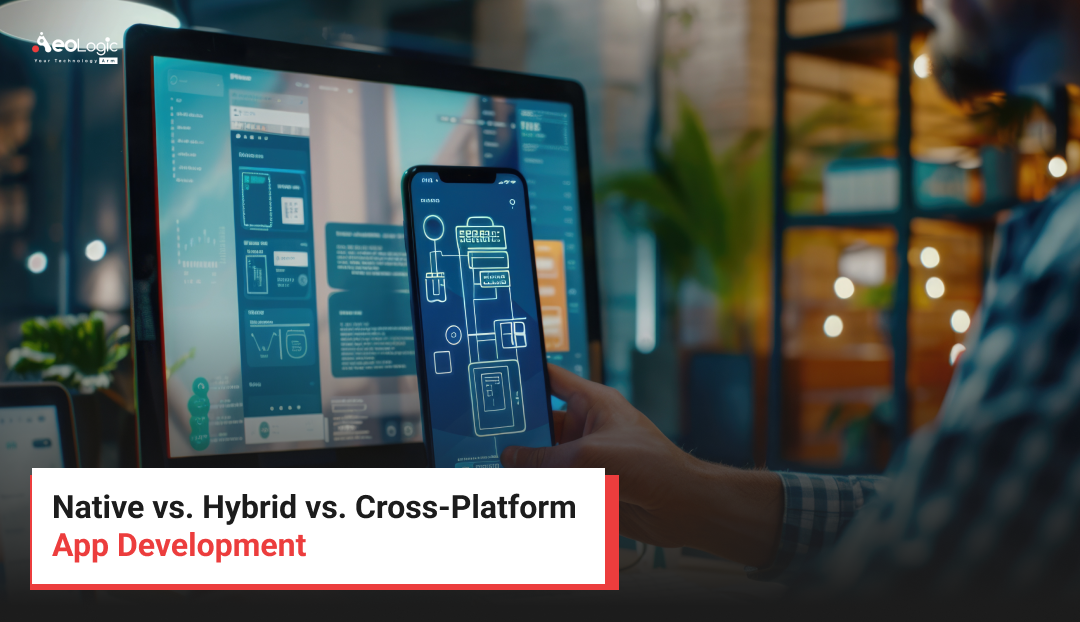When businesses plan to launch a mobile application, one question always comes first — which type of development approach should we use? Should you build a native app, go for a hybrid solution, or choose a cross-platform framework? The choice you make here directly affects app performance, budget, development time, and even user experience. With the rapid evolution of mobile technology, app development is no longer one-size-fits-all. Each approach has its pros, cons, and ideal use cases.
In this blog, we’ll simplify the debate of Native vs. Hybrid vs. Cross-Platform App Development so you can decide what best fits your project goals.
What Is Native App Development?
Native app development means building separate apps for each operating system — typically Android and iOS — using languages and tools approved by those platforms.
-
For Android, developers use Java or Kotlin with Android Studio.
-
For iOS, they use Swift or Objective-C with Xcode.
Because native apps are built specifically for each OS, they deliver:
-
High performance and speed
-
Better UI/UX alignment
-
Full access to device features (camera, GPS, Bluetooth etc.)
However, the downside is that you’ll need to maintain two separate codebases, which can double your cost and development time.
Example:
Instagram and WhatsApp started as native apps to ensure smooth functionality, offline access, and faster performance.
What Is Hybrid App Development?
Hybrid apps combine web and native technologies. They are essentially web applications wrapped in a native shell, allowing them to be distributed through app stores while using a single codebase.
Developers use web technologies such as HTML, CSS, and JavaScript and frameworks like Ionic or Cordova.
These apps run inside a native container and communicate with the device using plugins.
Advantages:
-
One codebase for multiple platforms
-
Faster development cycle
-
Lower cost
Drawbacks:
-
Slightly lower performance compared to native
-
Limited access to advanced device features
Example:
Apps like early versions of Twitter Mobile and Evernote used hybrid technology to reduce costs and time while keeping a good user experience.
What Is Cross-Platform App Development?
Cross-platform development aims to combine the best of both worlds — native performance with single-code simplicity.
Using frameworks like React Native, Flutter, or Xamarin, developers write one codebase that works on both Android and iOS.
Unlike hybrid apps, cross-platform apps render native components directly, resulting in faster and smoother performance.
Benefits:
-
Reduced development time and cost
-
Near-native performance
-
Consistent UI across platforms
Limitations:
-
Platform-specific bugs may still appear
-
Integration with complex hardware APIs may require custom coding
Example:
Facebook, Airbnb (old version), and Alibaba use cross-platform frameworks to maintain fast performance with shared codebases.
Why This Comparison Matters
In today’s fast-moving digital market, businesses can’t afford slow or inefficient development cycles. The choice between native, hybrid, and cross-platform directly affects:
-
Cost and timeline
-
User experience and performance
-
Maintenance and scalability
Whether you’re a startup launching your first app or an enterprise modernizing an existing product, knowing these differences helps you invest smarter and deliver faster.
Detailed Comparison: Native vs. Hybrid vs. Cross-Platform App Development
Here’s a closer look at how these three approaches differ in performance, user experience, scalability, and cost.
| Criteria | Native App Development | Hybrid App Development | Cross-Platform App Development |
|---|---|---|---|
| Codebase | Separate for Android and iOS | Single codebase for all platforms | Shared codebase for Android and iOS |
| Performance | Excellent – optimized for specific OS | Moderate – runs in a web container | Near-native performance |
| Development Time | Longer – separate teams needed | Shorter – same team builds for all | Medium – one team manages both |
| Cost | Higher – due to dual maintenance | Lower – single app for all | Medium – less costly than native |
| UI/UX Quality | Excellent – native look and feel | Good – depends on framework | Great – closer to native |
| Device Feature Access | Full – direct API access | Limited – via plugins | Partial – plugins or custom code needed |
| Maintenance | More complex – per platform | Easier – single update covers all | Easier than native, but may need tweaks |
| Examples | WhatsApp, Spotify, Instagram | Early Twitter, Evernote | Facebook, Alibaba, Pinterest |
This table shows why businesses must choose based on their goals — whether that’s performance, budget, or time-to-market.
Advantages of Native App Development
Native app development still remains the top choice for companies prioritizing performance and user experience.
Best Performance
Because native apps are compiled directly into machine code for each platform, they run smoother and faster than hybrid or cross-platform alternatives.
Access to Full Device Features
Native apps can easily access device hardware — such as the camera, GPS, sensors, and push notifications — without relying on third-party plugins.
Superior UI and UX
Native apps follow the platform’s design guidelines (like Material Design for Android or Human Interface Guidelines for iOS).
This ensures consistent, intuitive, and responsive experiences for users.
Offline Functionality
Native apps can run efficiently without internet connectivity, a big advantage for apps in remote or low-connectivity areas.
Best for:
-
Gaming apps
-
Banking and security apps
-
Complex enterprise apps that require hardware-level integration
Advantages of Hybrid App Development
Hybrid development is ideal for startups or businesses that need to launch fast without spending too much.
Faster Development
One codebase works for all platforms, reducing overall time to market.
Lower Cost
Since the same development team works on multiple platforms, it’s cost-efficient for small and mid-sized projects.
Simple Maintenance
Updates or fixes only need to be applied once — across Android, iOS, and even web versions.
Wider Reach
Hybrid apps make it easier to launch across platforms simultaneously, helping businesses target a larger audience quickly.
Best for:
-
Content-based or information apps
-
MVPs (Minimum Viable Products)
-
Small business applications
Advantages of Cross-Platform App Development
Cross-platform development offers a middle ground between performance and speed — giving businesses a balance of both worlds.
Shared Codebase
You write once, and deploy everywhere. This speeds up the process while maintaining strong performance levels.
Native-like Experience
Frameworks like Flutter and React Native provide near-native rendering, ensuring users can’t tell the difference in most cases.
Easy Maintenance
One codebase means fewer bugs, less redundancy, and easier updates.
Strong Community Support
Modern cross-platform tools are open-source and backed by tech giants (Flutter by Google, React Native by Meta), offering fast updates and huge developer communities.
Best for:
-
Startups with limited budgets
-
Businesses targeting multiple OS users
-
Apps needing good performance without full native cost
Real-World Examples of Each App Development Approach
Let’s look at how global companies use different app development approaches depending on their goals, audience, and resources.
Native App Development – When Performance Is Everything
Companies that prioritize speed, high responsiveness, and hardware-level access choose native apps.
Examples:
-
Instagram: Originally built natively for a smooth social experience with fast media uploads and real-time notifications.
-
Spotify: Uses native development for stable music streaming and offline functionality.
-
WhatsApp: Native code helps handle massive volumes of messages with minimal lag.
Native apps perform best for products requiring high-speed operations, custom UI, or deep device integration.
Hybrid App Development – When Speed and Cost Matter
Hybrid development suits businesses that need to enter the market fast and on a tight budget.
Examples:
-
Untappd: A beer discovery app built using hybrid technologies, allowing quick development and updates.
-
Evernote (early version): Combined native and web elements for faster deployment.
-
Twitter Mobile (earlier builds): Used hybrid architecture to reach a broad audience without doubling development work.
Hybrid apps offer decent performance and lower costs, perfect for MVPs and early-stage startups.
Cross-Platform App Development – When You Want Both Speed and Quality
Cross-platform frameworks now power many of the world’s most popular apps because they deliver near-native performance.
Examples:
-
Facebook: Its mobile apps use React Native for efficiency and smooth UI.
-
Alibaba: Built with Flutter to offer consistent performance across iOS and Android.
-
Airbnb (previously): Adopted React Native for faster updates and unified code management.
Cross-platform app development works best for companies aiming for wide audience coverage with balanced performance.
Challenges of Each App Development Approach
Each method has its strengths and weak points. Choosing the right one depends on your project’s requirements, team skills, and timeline.
Native App Development Challenges
-
Higher Development Cost: Building and maintaining two codebases for Android and iOS doubles the cost.
-
Time-Consuming: Developing two separate apps takes longer.
-
Team Requirement: You’ll need separate development teams for both platforms.
Hybrid App Development Challenges
-
Performance Issues: Hybrid apps rely on a webview, which can make complex apps laggy.
-
Limited Access to Device Features: Some hardware-level APIs can’t be fully utilized.
-
UI/UX Inconsistency: Designs may look slightly different across devices.
Cross-Platform App Development Challenges
-
Complex Debugging: Errors may appear differently on Android and iOS.
-
Limited Access to Native Features: Requires custom modules for certain advanced functionalities.
-
Dependency on Framework Updates: If frameworks lag behind OS updates, performance might temporarily drop.
Cost and ROI Comparison
| Factor | Native App Development | Hybrid App Development | Cross-Platform App Development |
|---|---|---|---|
| Initial Cost | High | Low | Medium |
| Time to Market | Long | Fast | Moderate |
| Performance | Excellent | Average | Good |
| Maintenance | Complex – two teams | Simple – one codebase | Easier – shared code |
| Scalability | High | Limited | High |
| User Experience | Best | Moderate | Near-Native |
| Long-Term ROI | High for large-scale apps | Low for long-term scaling | High for multi-platform strategy |
Key Takeaways from the Comparison
-
Native apps are perfect for enterprises and feature-heavy apps that demand top-tier performance.
-
Hybrid apps are ideal for startups or simple business apps looking to test ideas quickly.
-
Cross-platform apps are the future — providing balanced cost, speed, and performance for most modern projects.
The Future of App Development
The app development industry is evolving at a tremendous pace. As user demands grow and technology advances, the lines between native, hybrid, and cross-platform approaches are beginning to blur.
In the future, development tools will become smarter and more unified — allowing developers to build high-performance apps faster and at a lower cost.
Here’s what the future holds:
-
AI-powered development: Artificial Intelligence will help automate coding, testing, and optimization.
-
Progressive Web Apps (PWAs): Combining web and app functionality for faster, lightweight user experiences.
-
Cross-platform dominance: Frameworks like Flutter and React Native are improving so fast that they’re nearly indistinguishable from native apps.
-
AR/VR and IoT integration: Apps will connect seamlessly with smart devices, wearables, and immersive technologies.
The goal of modern app development will no longer be “just build an app” — it will be to build one app that works everywhere, intelligently.
Which App Development Approach Should You Choose?
The right choice depends entirely on your business objectives, target users, and project scale.
Here’s a quick breakdown to make it easier:
| If you need… | Choose… |
|---|---|
| The best performance and user experience | Native App Development |
| A quick, cost-effective launch | Hybrid App Development |
| A balance between cost, speed, and performance | Cross-Platform App Development |
| Complex features like gaming or AR | Native App Development |
| An MVP or startup app | Hybrid or Cross-Platform |
In short:
-
Go native for high-end, feature-rich apps.
-
Go hybrid if speed and cost matter most.
-
Go cross-platform for scalability and efficiency.
Modern businesses often adopt a hybrid strategy — using native apps for critical operations and cross-platform apps for scalability.
Final Words
The choice between native, hybrid, and cross-platform app development is more than a technical decision — it’s a strategic one.
Every approach has strengths:
-
Native offers unmatched performance.
-
Hybrid brings speed and simplicity.
-
Cross-platform delivers flexibility and scalability.
As businesses embrace digital-first strategies, the ultimate goal is to deliver a seamless user experience — no matter what technology runs underneath.
Remember: great apps don’t just work — they connect, engage, and evolve with users.
If your goal is to build an app that does exactly that, choosing the right development model is your first step toward success.
FAQs
1. Which app development approach is most cost-effective?
Hybrid and cross-platform approaches are generally cheaper because they use a single codebase for multiple platforms.
2. Is native app development still relevant in 2025?
Absolutely. For apps that need high performance, security, or offline access, native remains the best choice.
3. Can I convert a hybrid or cross-platform app into a native one later?
Yes, but it will require rewriting most of the code. Aeologic helps clients plan this migration efficiently when scaling.
4. Which framework is best for cross-platform app development?
Flutter and React Native are currently the most popular and reliable options for performance and flexibility.
5. How can Aeologic help with app development?
Aeologic offers end-to-end mobile app development services — from concept to launch — including native, hybrid, and cross-platform builds tailored to your business goals.

Passionate about breaking down complex tech into simple ideas. Covers everything from AI and software development to gadgets and emerging tech trends.






